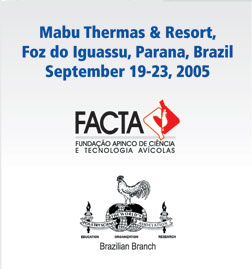Contributed Papers: Oral Presentations
Chemotherapy |
Anticoccidial
sensitivity profiles of recently obtained Dutch, German,
and Spanish Eimeria spp. isolates
H.W. Peek and W.J.M. Landman
h.peek@gdvdieren.nl
Animal Health Service Ltd., P.O. Box 9, 7400 AA Deventer,
the Netherlands
Abstract
Anticoccidial sensitivity profiles of thirty nine
Eimeria spp. field isolates collected from broiler
farms between 1996 and 2002 were determined. The tested
products were: diclazuril (ClinacoxÒ: 1 mg/kg),
halofuginone (StenorolÒ: 3 mg/kg), lasalocid
(AvatecÒ: 90 mg/kg) , maduramycin (Cygro®:
5 mg/kg), meticlorpindol/methylbenzoquate (LerbekÒ:
100 mg/kg), monensin (ElancobanÒ: 100 mg/kg),
narasin ((MontebanÒ: 70 mg/kg), narasin/nicarbazin
(MaxibanÒ: 40/40 mg/kg), nicarbazin (NicarbÒ:
125 mg/kg), robenidine (RobenzÒ: 33 mg/kg)
and salinomycin (SacoxÒ: 60 mg/kg). The tests
were performed in battery cages. The sensitivity profile
of each Eimeria spp. present in the field isolates
was based on the reduction of the mean lesion score
of the infected medicated group as compared to the
infected unmedicated birds. A reduction percentage
of 0-30% indicates resistance, 31-49% reduction indicates
reduced sensitivity, and 50% or more indicates full
sensitivity. Most field isolates (n = 21) consisted
of mixtures of two or three Eimeria spp., while eighteen
isolates comprised a single species (E. acervulina
n = 16; E. maxima and E. tenella in the other cases).
Regarding the distribution of species, E. acervulina
was most frequently found (n = 37) followed by E.
maxima (n = 15) and E. tenella (n = 12). Almost all
Eimeria spp. found in the field isolates showed resistance
or decreased sensitivity against the selected anticoccidial
drugs. Exceptions were some Eimeria acervulina strains,
which were sensitive to diclazuril (2/30), meticlorpindol/methylbenzoquate
(17/19), monensin (3/20), narasin (5/25), narasin/nicarbazin
(1/16), nicarbazin (3/30), robenidine (3/6) and salinomycine
(11/36). All E. acervulina isolates tested against
halofuginone (n =16), lasalocid (n =19) and maduramycin
(n = 4) showed resistance or decreased sensitivity.
Some E. maxima strains showed sensitivity to diclazuril
(1/11), halofuginone (4/5), meticlorpindol/methylbenzoquate
(6/9), narasin (2/8), narasin/nicarbazine (5/8), nicarbazin
(4/13), robenidine (1/1), and salinomycin (3/14).
All E. maxima isolates tested for lasalocid (n = 3),
maduramicin (n = 1) and monensin (n = 6) showed resistance
or decreased sensitivity. A number of E. tenella strains
were sensitive to diclazuril (4/11), halofuginone
(3/3), lasalocid (2/8), maduramycin (1/1), meticlorpindol/methylbenzoquate
(7/7), monensin (1/8), narasin (2/10), nicarbazin
(2/11), robenidine (1/1), and salinomycin (1/12).
All E. tenella isolates (n = 4) tested for narasin/nicarbazin
showed resistance. The present study shows that resistance
against most anticoccidial drugs, except meticlorpindol/methylbenzoquate,
is fairly common amongst European coccidiosis field
isolates.
